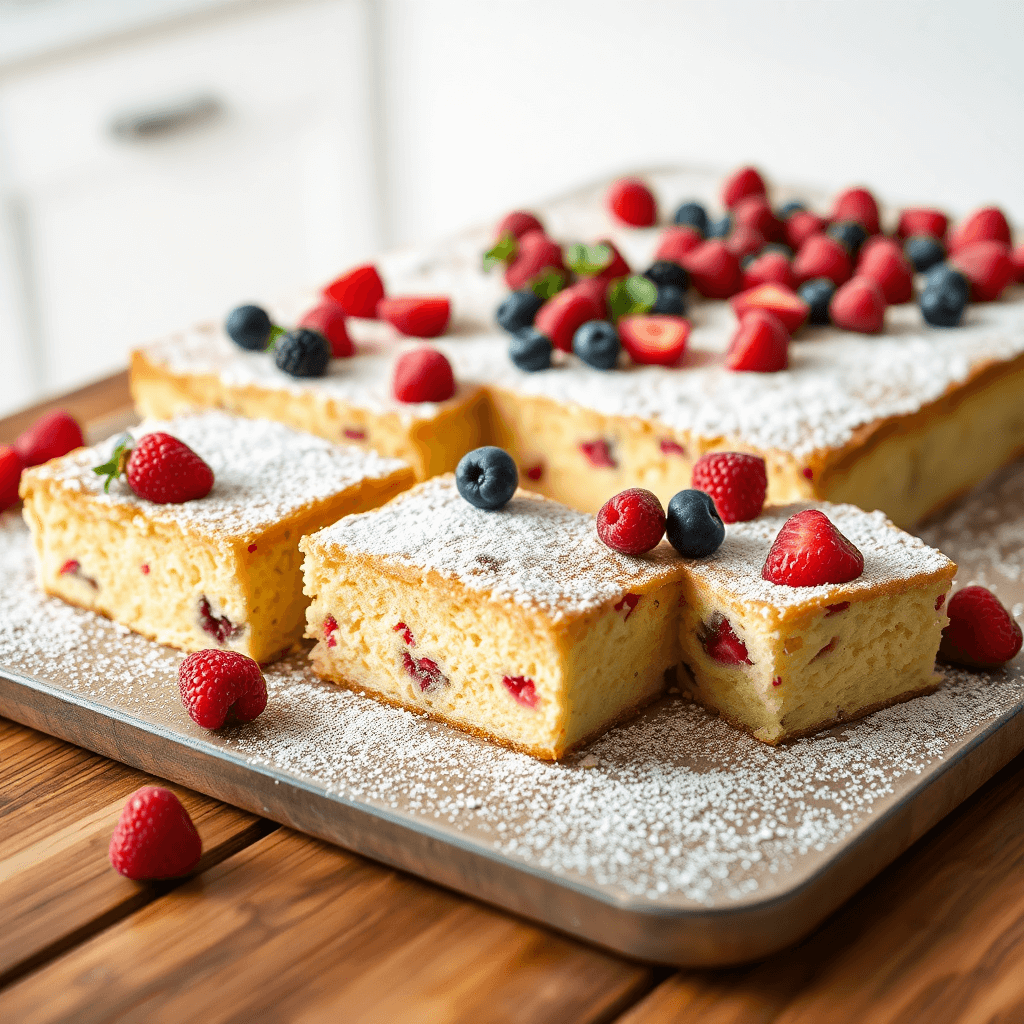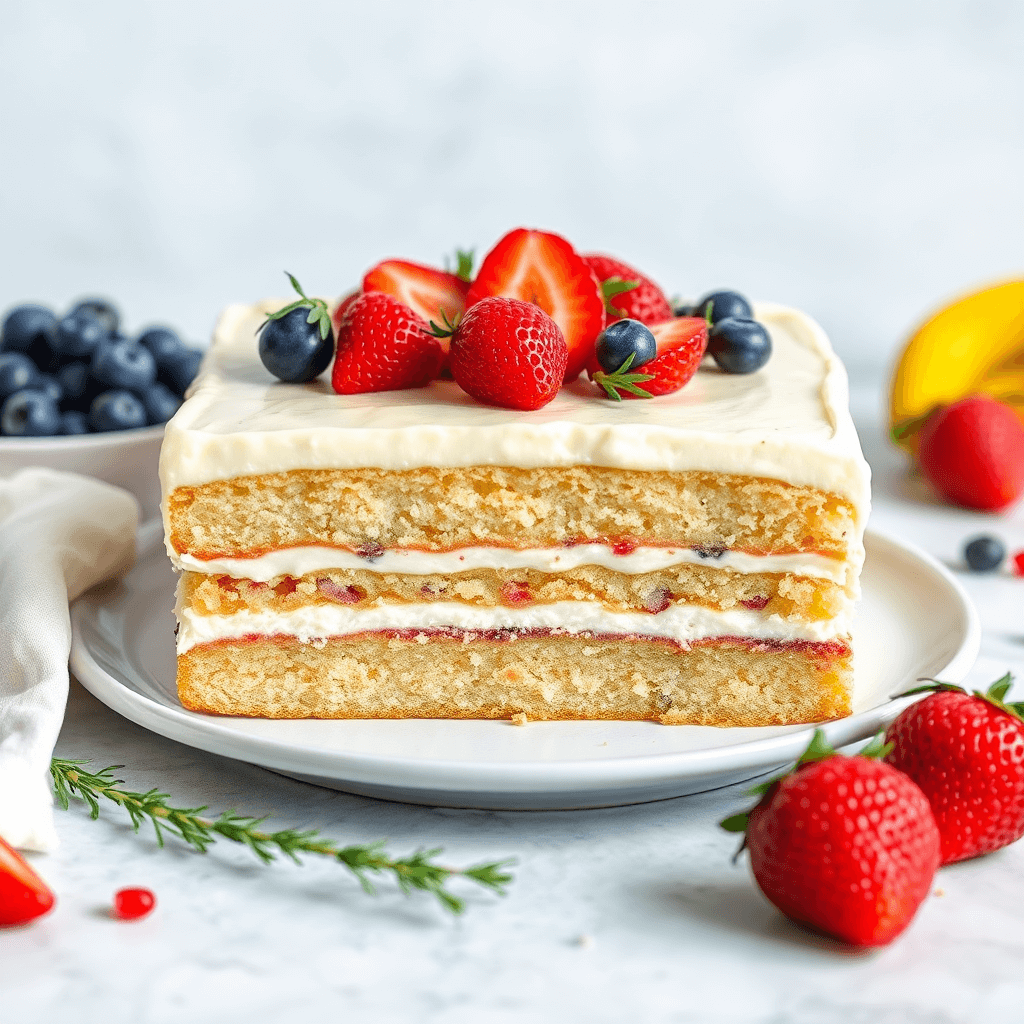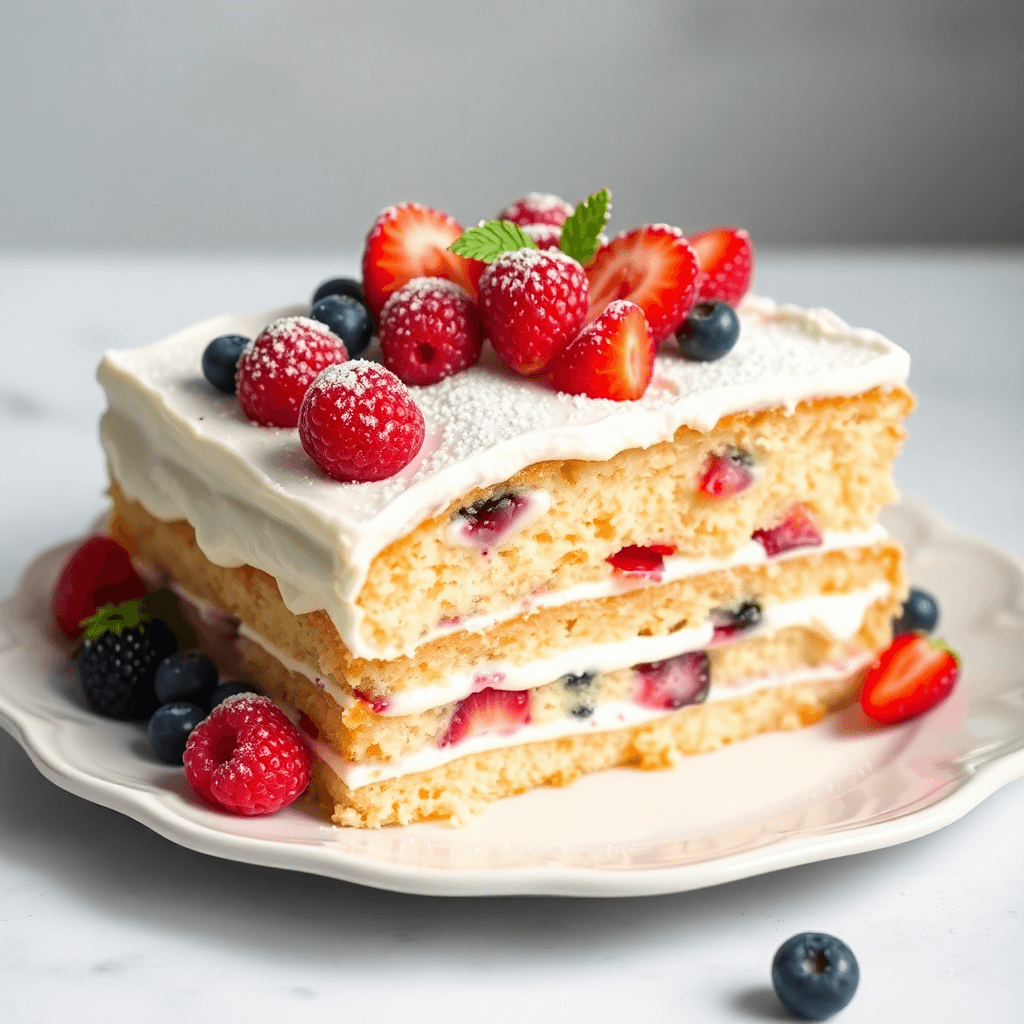If you’re a fan of light, fluffy, and moist cakes, you’re in for a treat! A kefir sheet cake is a perfect blend of simplicity and deliciousness, making it a go-to dessert for any occasion.
Kefir, a fermented milk product, isn’t just a health trend—it’s a game-changer in baking. Its natural acidity and creamy texture help create soft, tender cakes with a delightful tangy flavor. Unlike other desserts that may feel heavy, this cake offers a balanced sweetness and a light crumb that’s hard to resist.
In this post, you’ll learn how to make the perfect kefir sheet cake from scratch. Whether you’re a seasoned baker or a beginner, this recipe is designed to be straightforward and foolproof. Plus, you’ll discover tips, tricks, and creative ways to enjoy this versatile dessert.

What Makes Kefir a Great Ingredient for Baking?
Baking with kefir might not be the first thing that comes to mind, but it’s a secret weapon for creating incredibly moist, tender, and flavorful baked goods. Here’s why kefir deserves a spot in your pantry—and your recipes.
1. Natural Acidity for Better Texture
Kefir is slightly tangy due to its natural acidity, which interacts beautifully with leavening agents like baking soda and baking powder. This reaction produces carbon dioxide bubbles, which help the batter rise and result in an airy, fluffy cake. It’s the same principle behind using buttermilk in baking, but kefir offers a deeper, more nuanced flavor.
2. Adds Moisture Without Making the Cake Heavy
One of the challenges in baking is balancing moisture without making the final product dense. Kefir has a creamy consistency that integrates smoothly into the batter, providing just the right amount of hydration. The result? A soft, moist cake that holds its shape and texture beautifully.
3. Rich in Probiotics and Nutrients
Unlike most traditional baking ingredients, kefir is packed with probiotics—beneficial bacteria that support gut health. While some of these may not survive the baking process, kefir also contains vitamins like B12, calcium, and potassium, which add a nutritious boost to your dessert.
4. Enhances Flavor
Kefir’s tangy profile adds depth and complexity to baked goods, balancing sweetness with a subtle tartness. This makes it especially perfect for desserts like a sheet cake, where the flavor of the cake itself takes center stage.
5. A Versatile Ingredient
Kefir isn’t just limited to cakes—it’s a versatile ingredient that can replace milk, buttermilk, or even yogurt in a variety of recipes. Whether you’re making pancakes, muffins, or bread, kefir adapts seamlessly, improving texture and taste across the board.
6. Suitable for Lactose-Sensitive Bakers
Since kefir is a fermented product, much of the lactose in the milk is broken down during the fermentation process. This makes it easier to digest and a great option for those who are lactose-sensitive but still want to enjoy dairy-based baked goods.
By using kefir in your sheet cake recipe, you’re not only creating a dessert with superior taste and texture but also incorporating a wholesome, nutrient-packed ingredient. It’s the perfect example of how traditional foods can transform modern baking into something truly special.
Ingredients You’ll Need for the Perfect Kefir Sheet Cake
Creating the perfect kefir sheet cake starts with selecting the right ingredients. Each component plays a crucial role in delivering the moist, fluffy, and flavorful cake you’re aiming for. Let’s break down what you’ll need and why each ingredient matters.
1. Kefir
First and foremost, kefir is the star of this recipe. It adds a signature tanginess and creamy texture to the cake. Furthermore, its natural acidity helps activate the baking soda, giving your cake a soft and airy crumb. Use plain, unsweetened kefir for the best results. If you prefer a slightly richer cake, opt for whole-milk kefir; on the other hand, low-fat kefir works well if you’re aiming for a lighter version.
2. All-Purpose Flour
Next, you’ll need all-purpose flour, which provides the structure your cake needs. To ensure an even texture, make sure to sift the flour before mixing it into the batter. Additionally, if you want to experiment, you can substitute part of the all-purpose flour with whole wheat or almond flour. However, keep in mind that this may slightly alter the cake’s texture.
3. Baking Soda and Baking Powder
Both baking soda and baking powder are essential for achieving a light and fluffy texture. Baking soda works in tandem with the acidic kefir to create a chemical reaction that releases carbon dioxide, helping the cake rise. Meanwhile, baking powder provides an extra lift, ensuring the cake bakes evenly.
4. Eggs
Eggs bind the ingredients together and contribute to the cake’s richness and structure. For best results, always use room-temperature eggs, as they mix more evenly into the batter. If you’re looking for an egg substitute, options like applesauce or flaxseed meal can work in a pinch.
5. Sugar
Of course, sugar is essential for adding sweetness to balance the tanginess of the kefir. White granulated sugar is the standard choice, but you can also experiment with brown sugar for a deeper, caramel-like flavor. Moreover, you can adjust the quantity if you prefer a less sweet cake or plan to add a sweet glaze or frosting later.
6. Butter or Oil
Fat is another key ingredient for creating a moist and tender cake. Butter adds richness and a classic flavor, while oil (such as vegetable or sunflower oil) ensures the cake stays moist for longer. If you choose butter, be sure to melt it and let it cool slightly before mixing it in.
7. Vanilla Extract
A splash of vanilla extract enhances the flavor profile of the cake, adding a warm, sweet aroma. For a more intense flavor, consider using pure vanilla extract instead of artificial versions.
8. Optional Add-Ons
Finally, consider including optional add-ons to customize your cake:
- Nuts: Add chopped walnuts, pecans, or almonds for a crunchy texture.
- Dried Fruit: Raisins, cranberries, or chopped apricots can add bursts of sweetness.
- Chocolate Chips: For a more indulgent cake, fold in some chocolate chips.
- Spices: A pinch of cinnamon or nutmeg can complement the tanginess of the kefir beautifully.
9. Frosting or Glaze
While optional, a topping can elevate your kefir sheet cake to the next level. For instance, consider cream cheese frosting for a rich and tangy finish. Alternatively, a simple powdered sugar glaze adds a sweet, light touch. If you prefer something fresh, a dollop of whipped cream and fresh fruit can be a delightful choice.
10. Pinch of Salt
Lastly, don’t skip the salt! A small pinch balances the sweetness and enhances the overall flavor of the cake.
By gathering these simple, wholesome ingredients, you’re setting yourself up for success in making the perfect kefir sheet cake. Once you’ve got everything ready, it’s time to dive into the recipe itself!

Step-by-Step Recipe for a Moist and Fluffy Kefir Sheet Cake
Baking a kefir sheet cake is simple and satisfying. Follow this guide to ensure your cake turns out perfectly moist, fluffy, and delicious every time.
Step 1: Gather Your Ingredients and Tools
Before starting, check that you have all the necessary ingredients and tools. Essential items include kefir, flour, eggs, sugar, butter or oil, baking soda, baking powder, and vanilla extract. Additionally, keep mixing bowls, a whisk, a spatula, a sheet pan, and parchment paper handy. Preparing everything ahead of time will make the process much smoother.
Step 2: Preheat the Oven and Prepare the Pan
Begin by preheating your oven to 350°F (175°C) to ensure it’s at the right temperature when your batter is ready. Line a sheet pan with parchment paper or grease it with butter or cooking spray, which will help the cake release easily after baking.
Step 3: Mix the Dry Ingredients
Start by combining the flour, baking soda, baking powder, and a pinch of salt in a large bowl. Whisk these ingredients together to evenly distribute the leavening agents, ensuring a uniform rise in your cake.
Step 4: Prepare the Wet Ingredients
Whisk the eggs in a separate bowl until they’re light and frothy, introducing air into the batter for added fluffiness. Gradually add sugar and mix until the mixture becomes pale and creamy. Follow this by pouring in the kefir, melted butter (or oil), and vanilla extract, then whisk everything together until smooth.
Step 5: Combine the Wet and Dry Ingredients
Slowly incorporate the dry ingredients into the wet mixture in three batches. Use a spatula to gently fold the batter after each addition, taking care to avoid overmixing. Overmixing could result in a dense texture, so mix only until combined.
Step 6: Pour the Batter into the Pan
With the batter ready, transfer it to the prepared sheet pan. Spread it evenly using a spatula, ensuring it reaches all corners for uniform baking.
Step 7: Bake the Cake
Place the pan in the preheated oven and bake for 25–30 minutes. To check for doneness, insert a toothpick into the center; it should come out clean or with only a few moist crumbs.
Step 8: Cool the Cake
Once baked, remove the cake from the oven and allow it to cool in the pan for about 10 minutes. Then transfer it to a wire rack to cool completely, preventing the bottom from becoming soggy.
Step 9: Add Frosting or Glaze (Optional)
If you’d like to decorate your cake, consider frosting it with cream cheese frosting or drizzling a powdered sugar glaze on top. For a simple option, dust the cake lightly with powdered sugar. Whipped cream and fresh fruit also make delightful toppings.
Step 10: Slice and Serve
When the cake is fully cooled, use a sharp knife to slice it into squares or rectangles. Serve the slices as they are or alongside a cup of coffee or tea for a perfect treat.
Pro Tips for Baking Success
- To achieve the best results, always use room-temperature ingredients like eggs and kefir.
- Keep a close eye on the cake during the final minutes of baking to avoid overbaking.
- Feel free to customize your cake by adding nuts, chocolate chips, or spices for a unique twist.
With these steps, you’ll create a kefir sheet cake that’s not only easy to make but also guaranteed to impress your friends and family. Let’s move on to decorating and serving ideas!

Tips and Tricks for the Perfect Sheet Cake Every Time
To consistently achieve a moist, fluffy, and flavorful sheet cake, it’s important to follow some essential tips and tricks. These simple yet effective techniques will elevate your baking game and ensure your kefir sheet cake turns out perfectly every time.
1. Use Room-Temperature Ingredients
One of the most crucial tips for any cake recipe is to use room-temperature ingredients, such as eggs, kefir, and butter. Room-temperature ingredients blend together more easily, resulting in a smoother batter. This small step helps create a cake with a more even texture and better rise.
2. Don’t Overmix the Batter
While it’s important to mix the ingredients until just combined, overmixing can cause the gluten in the flour to develop too much. This leads to a dense, rubbery texture instead of a light, fluffy cake. Use a spatula or a hand whisk to gently fold the batter, stopping as soon as you no longer see dry flour.
3. Measure Ingredients Accurately
Baking is a science, and precise measurements are key to success. Use measuring cups for dry ingredients and a liquid measuring cup for wet ingredients. Additionally, consider weighing your ingredients with a kitchen scale for the most accurate results. Too much flour, for instance, can make the cake dry, while too little can cause it to collapse.
4. Sift Your Dry Ingredients
Sifting flour, baking soda, and baking powder ensures they are evenly distributed and free of lumps. This step not only helps create a uniform batter but also contributes to the cake’s soft and tender texture.
5. Preheat the Oven
Always preheat your oven before placing the cake inside. Baking at the correct temperature from the start ensures the batter begins rising immediately, which is essential for a well-baked cake. An oven thermometer can be a helpful tool to verify your oven’s temperature.
6. Prepare the Pan Properly
Grease your sheet pan thoroughly with butter or cooking spray, or line it with parchment paper. This prevents the cake from sticking and allows for easy removal. For added convenience, trim the parchment paper to fit the pan perfectly.
7. Check for Doneness
To avoid overbaking or underbaking, check the cake for doneness a few minutes before the suggested baking time ends. Insert a toothpick or skewer into the center of the cake; it should come out clean or with just a few moist crumbs. If the toothpick comes out wet, give the cake a few more minutes and test again.
8. Let the Cake Cool Completely
Cooling your cake properly is just as important as baking it. Let it cool in the pan for about 10 minutes before transferring it to a wire rack. A hot cake is delicate and prone to breaking, so handle it carefully. Cooling on a wire rack allows air to circulate around the cake, preventing it from becoming soggy.
9. Experiment with Flavor Additions
Although the classic kefir sheet cake is delicious on its own, don’t hesitate to get creative. Add spices like cinnamon or cardamom for warmth, or mix in ingredients like chocolate chips, dried fruit, or nuts for added texture and flavor.
10. Frosting and Decoration Tips
If you’re planning to frost or decorate your cake, make sure it’s completely cooled first. A warm cake can cause the frosting to melt and slide off. Use an offset spatula for even spreading, and consider sprinkling chopped nuts, grated chocolate, or edible flowers for a professional finish.
11. Storage Tips
Store your sheet cake properly to maintain its freshness. If unfrosted, wrap it tightly in plastic wrap or aluminum foil and keep it at room temperature for up to two days. For frosted cakes, store them in an airtight container in the refrigerator to prevent the frosting from drying out.
12. Practice Makes Perfect
Lastly, don’t be discouraged if your first attempt isn’t flawless. Baking is a skill that improves with practice. With each batch, you’ll become more familiar with your oven, ingredients, and techniques, leading to consistently amazing results.
By keeping these tips and tricks in mind, you can ensure your kefir sheet cake turns out perfect every time, whether you’re baking for a special occasion or simply enjoying a homemade treat. Ready to take your cake to the next level? Let’s explore some creative variations and presentation ideas!
